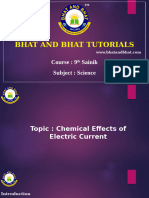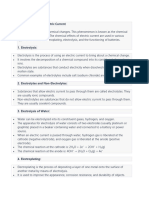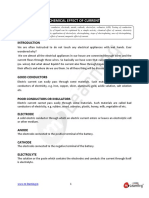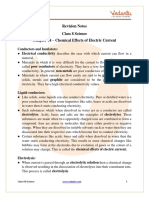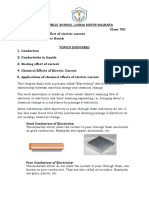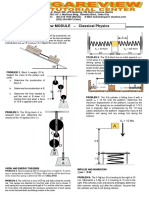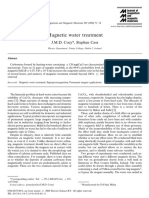Class 8 Science Chemical Effects of Electric Current Notes RK Learning Hub
Class 8 Science Chemical Effects of Electric Current Notes RK Learning Hub
Uploaded by
RajkumarCopyright:
Available Formats
Class 8 Science Chemical Effects of Electric Current Notes RK Learning Hub
Class 8 Science Chemical Effects of Electric Current Notes RK Learning Hub
Uploaded by
RajkumarOriginal Title
Copyright
Available Formats
Share this document
Did you find this document useful?
Is this content inappropriate?
Copyright:
Available Formats
Class 8 Science Chemical Effects of Electric Current Notes RK Learning Hub
Class 8 Science Chemical Effects of Electric Current Notes RK Learning Hub
Uploaded by
RajkumarCopyright:
Available Formats
Class 8 Science: Chemical Effects of Electric Current (NCERT Notes)
Institute: R.K Learning Hub
Notes by Raj Sir
Introduction to Electric Current
Electric current is the flow of electric charge through a conductor. It is used in various devices to
produce heat, light, and other effects. The unit of electric current is Ampere (A).
Chemical Effects of Electric Current
When electric current passes through a conducting solution, it can cause chemical reactions. This is
known as the chemical effect of electric current. These effects include the formation of bubbles,
deposition of metals, and changes in the color of solutions.
Electrolytes
Substances that allow electric current to pass through them when dissolved in water are called
electrolytes. Examples: Saltwater, acids, and bases. Non-electrolytes do not conduct electricity, e.g.,
distilled water.
Electrolysis
The process of using electric current to cause a chemical reaction is called electrolysis. It is used to
decompose compounds into their elements.
Example: Electrolysis of water produces hydrogen and oxygen gases.
Electroplating
Electroplating is a process that uses electric current to deposit a thin layer of metal onto another
metal. It is used for coating objects with a metal layer to prevent rusting or to enhance their
appearance.
Example: Coating iron with a layer of zinc to prevent rusting (galvanization).
Applications of Electroplating
- Gold plating on jewelry to enhance appearance.
- Chromium plating on car parts to prevent corrosion.
- Silver plating on utensils for a shiny finish.
Conductors and Insulators
Materials that allow electric current to pass through them are called conductors. Example: Metals
like copper and aluminum.
Materials that do not allow electric current to pass through them are called insulators. Example:
Rubber, plastic, and wood.
Testing Conductivity of Liquids
To test whether a liquid conducts electricity, we can use a simple circuit with a bulb or an LED.
- If the bulb glows, the liquid is a good conductor.
- If the bulb does not glow, the liquid is a poor conductor or insulator.
Distilled water is a poor conductor, while saltwater is a good conductor.
Electrolytic Cell
An electrolytic cell is a setup used for electrolysis, consisting of two electrodes (anode and cathode)
and an electrolyte solution. The positive electrode is called the anode, and the negative electrode is
called the cathode.
Effects of Electric Current
Apart from chemical effects, electric current can also produce:
- **Heating Effect**: Example - Electric heater, electric iron.
- **Magnetic Effect**: Example - Electromagnets, electric bell.
Key Terms to Remember
- Electrolyte: A substance that conducts electricity when dissolved in water.
- Electrolysis: Chemical reaction caused by passing electric current through a solution.
- Electroplating: Coating of a metal surface with another metal using electric current.
- Conductor: A material that allows electric current to flow.
- Insulator: A material that does not allow electric current to flow.
Interesting Facts about Electric Current
- Pure water does not conduct electricity, but adding a small amount of salt makes it a good
conductor.
- Electroplating is widely used in the automobile industry to protect car parts from corrosion.
- Lemon juice can be used as an electrolyte in simple circuits like a lemon battery.
You might also like
- CHM2123 - Organic Chemistry Laboratory Ii: FALL 2020 - SyllabusNo ratings yetCHM2123 - Organic Chemistry Laboratory Ii: FALL 2020 - Syllabus6 pages
- CH-14_Chemical_Effects_of_Electric_CurrentNo ratings yetCH-14_Chemical_Effects_of_Electric_Current17 pages
- Chapter 11 Chemical Effects of Electric CurrentNo ratings yetChapter 11 Chemical Effects of Electric Current18 pages
- Science - L-13 Chemical Effects of Electric Current Notes (VIII)No ratings yetScience - L-13 Chemical Effects of Electric Current Notes (VIII)6 pages
- Science-Chemical Effects of Electric CurrentNo ratings yetScience-Chemical Effects of Electric Current33 pages
- Quickcard Class-VIII (Science) Chapter-14 Chemical Effects of Electric CurrentNo ratings yetQuickcard Class-VIII (Science) Chapter-14 Chemical Effects of Electric Current5 pages
- Chemical Effects of Electric Current-Key NotesNo ratings yetChemical Effects of Electric Current-Key Notes6 pages
- L 14 Chemical Effects of Electric CurrentNo ratings yetL 14 Chemical Effects of Electric Current31 pages
- Revision Notes Class 8 Science Chapter 14 - Chemical Effects of Electric CurrentNo ratings yetRevision Notes Class 8 Science Chapter 14 - Chemical Effects of Electric Current2 pages
- Science Notes Chapter 14 Chemical Effects of Electric Current (Class 8)No ratings yetScience Notes Chapter 14 Chemical Effects of Electric Current (Class 8)10 pages
- Chapter 14 Chemical Effects of Electric Current 21-1-2025No ratings yetChapter 14 Chemical Effects of Electric Current 21-1-20256 pages
- 2024 VIII CHEM NOTES Ch11 Chemical Effects of Electric Currents - KaushikNo ratings yet2024 VIII CHEM NOTES Ch11 Chemical Effects of Electric Currents - Kaushik6 pages
- CHEMICAL EFFECTS OF ELECTRIC CURRENT PPT CLASS 8No ratings yetCHEMICAL EFFECTS OF ELECTRIC CURRENT PPT CLASS 817 pages
- Study Material - Chemical - Effect - of - Electric Current - classVIIINo ratings yetStudy Material - Chemical - Effect - of - Electric Current - classVIII15 pages
- Viii Sci L14 M02 Chemical Effects of Electric Current HandoutNo ratings yetViii Sci L14 M02 Chemical Effects of Electric Current Handout2 pages
- Class 8 - Chapter 14 - Chemical Effect and Electric CurrentNo ratings yetClass 8 - Chapter 14 - Chemical Effect and Electric Current3 pages
- Chapter 14 - Chemical Effects of Electric CurrentNo ratings yetChapter 14 - Chemical Effects of Electric Current2 pages
- CLASS 8TH CHEMICAL EFFECT OF CURRENT NOTESNo ratings yetCLASS 8TH CHEMICAL EFFECT OF CURRENT NOTES8 pages
- CHEMICAL EFFECTS OF ELECTRIC CURRENT GR 8No ratings yetCHEMICAL EFFECTS OF ELECTRIC CURRENT GR 86 pages
- Physics Chemical Effects of Electric Current Short Type Questions With Their AnswersNo ratings yetPhysics Chemical Effects of Electric Current Short Type Questions With Their Answers3 pages
- Answer Key GR8Chemical Effects of Electric Current WorksheetNo ratings yetAnswer Key GR8Chemical Effects of Electric Current Worksheet3 pages
- Chemical Effects of Electric Current EXTRA QUESTIONNo ratings yetChemical Effects of Electric Current EXTRA QUESTION6 pages
- Conductors and Insulators Electricity Kids Book | Electricity & ElectronicsFrom EverandConductors and Insulators Electricity Kids Book | Electricity & ElectronicsNo ratings yet
- Class 8 Geography Industries Notes Questions RK Learning HubNo ratings yetClass 8 Geography Industries Notes Questions RK Learning Hub4 pages
- Cc-Xiii Practical Record..on Research Fossil Etc.No ratings yetCc-Xiii Practical Record..on Research Fossil Etc.13 pages
- Analytical Reference Materials International: Certificate of AnalysisNo ratings yetAnalytical Reference Materials International: Certificate of Analysis2 pages
- Why You Need To Consider The PTFE Dielectric Constant in Your ApplicationNo ratings yetWhy You Need To Consider The PTFE Dielectric Constant in Your Application10 pages
- Review Module 11 Classical Physics Part 2No ratings yetReview Module 11 Classical Physics Part 22 pages
- SPM-Chemistry-Formula-List-Form4 (BM) PDFNo ratings yetSPM-Chemistry-Formula-List-Form4 (BM) PDF12 pages
- The Dosimetric Feasibility of Gold Nanoparticle-Aided Radiation Therapy (GNRT) Via Brachytherapy Using Low-Energy Gamma-/x-Ray SourcesNo ratings yetThe Dosimetric Feasibility of Gold Nanoparticle-Aided Radiation Therapy (GNRT) Via Brachytherapy Using Low-Energy Gamma-/x-Ray Sources18 pages
- Gold Tin - The Unique Eutectic Solder AlloyNo ratings yetGold Tin - The Unique Eutectic Solder Alloy2 pages
- DocumentMSA Portable Gas Detection Methane As A Pentane Simulant vs. Pentane CalibrationNo ratings yetDocumentMSA Portable Gas Detection Methane As A Pentane Simulant vs. Pentane Calibration2 pages






